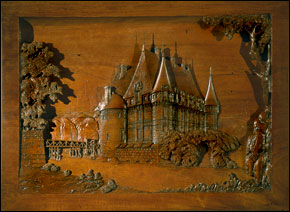
Translation by Diana Aitova
In 1999, woodcarver Leonid Zakurdayev and his wife, Svetlana, left their home in Moscow to visit some friends in Canada. While there, they came down into Minnesota to see the U.S. He had his tools with him, because, he says, he always travels with them. Apparently, he liked what he saw, and a friend from Moscow currently living in Minnesota managed to get him a four-month guest visa.
Working out of his friend’s basement, he made several carvings and, on a whim, exhibited them in the 33rd Annual International Wood Carvers Congress Exhibition in Iowa. He submitted five carvings and managed to net six blue ribbons, two red ribbons and the first place prize for one of his pieces. He was the first Russian to ever enter the competition, and he clearly made a clean sweep of it. Later that same year, he went on to win the Best Carving Award at the Annual Northern Woods Exhibition of Fine Woodworking in Minneapolis, Minnesota.
No doubt many other carvers were wondering “Who is this guy, where did he come from, where has he been hiding, and where did he learn to do such work?” That was more or less what I wondered when I first encountered his pieces in Philadelphia, where he currently lives. I decided to give him a call and find out, but since he is far more comfortable in his native language, I first enlisted the aid of a friend, Diana Aitova, to act as translator. What I discovered is quite a story.
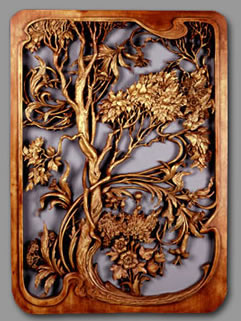
As is typical in Russia , Leonid finished the equivalent of high school at 18, then went into the army. At 21, he went to Stroganovskoe College of Artistic Design, a government-supported school for the arts. At that time, it was free to go there, but only seven people got in per year, so it was quite competitive. Entering required taking a three-day skills exam covering drawing, various techniques and composition to assess one’s artistic abilities and leanings.
Ironically, Leonid was trying to get into a jewelry program, but went through the wrong door and ended up in the wrong examination room. After three days, he was rather astonished to find that he had unknowingly been testing to get into a program for restoring furniture and woodcarving. Even more amazing, he was accepted to the program. In retrospect, he is not at all sorry, though he never has done any jewelry making.
He spent three and a half years in school learning about different types of wood, restoration, machine use and, of course, hand carving. “Machinery work was definitely secondary,” he explained, “and hand tool work was encouraged.” After graduation, he spent three years working on the famous Church of Christ the Savior in Moscow. At the time, Russia was knee-deep in trying to repair some of the beautiful churches that had fallen into disrepair due to a lack of religion during the Communist regime. He reproduced 10 carved altar columns and admits that being involved with the church’s restoration was a great honor.
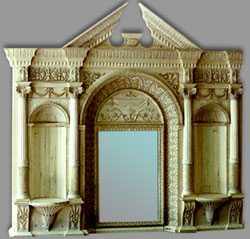
About the same time, he met his wife, and the two opened a business together building and restoring woodwork, mostly for the government buildings and for rich government clients. He even carved a government seal for the city of Moscow for the Duma, their equivalent of Congress. They did a lot of architectural interiors, Gothic style bookcases, fireplaces and furniture, often working from nothing more than a picture or drawing.
Svetlana was trained as an interior designer, and they work together designing and creating. He does the carving and major woodwork, but they both do finishing. “It is good to have another opinion and a fresh look,” he insists. “I trust the advice she gives me. We work until we are both happy with what we have, but we are both perfectionists. Of course, that means that every project is only two steps away from a divorce,” he joked.
In 1989, after the Iron Curtain was lifted, they started traveling in Europe, going each year to a different country for a month at a time. “There was much to learn,” he recalls, “and we wanted to see how others did things.” Then came the fateful trip to the U.S., a handful of prizes, and many more to follow. All told, he admits he has won over 50 first prize and best of show awards during his short time here in the United States alone, and a few in Russia as well, though he says Russia is not as big on awards as we are. “Honors are not important to me; I am simply proud of our work and projects.”
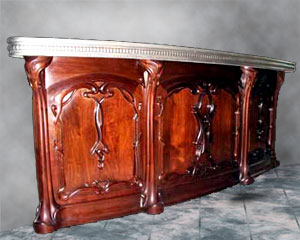
As a result of this recognition, and of his amazing skills, Leonid was granted a permanent visa with the rare status citing “extraordinary ability” in his craft. He has since acquired a green card, which enables him to stay in the U.S. permanently, and is working toward American citizenship. He wants to travel, including going back to Russia to teach and work, but still retain the ability to come back here, and citizenship will facilitate that. All of their family is still in Russia, and they have been back twice for visits.
Their decision to remain here in the U.S. came in spite of the fact that it meant giving up a successful business in Moscow. They got an apartment in St. Paul, Minnesota, took some private commissions, and started teaching classes at a local woodworking school. After noting that some of the larger high-end shows were on the East Coast, they moved to Philadelphia. For a year, Leonid taught out of Jeffrey Lohr’s woodworking school before he and his wife set up their own school and woodworking business. “Teaching is very interesting,” Leonid explained. “You see people with eyes shining and trying very hard. Besides, it feels good to share and help people to rise to a new level, help them achieve, and feel good about what they are doing. There are a lot of very talented woodworkers in my classes. In each class, they do a design that teaches a particular technique that they can use in their own work. I teach them how to do things quickly, easily, and how to work without mistakes. It is important to teach even beginners these steps.”
To stretch their educational reach even farther, they are currently writing a book called Wood Carving for the Mind’s Eye with Linden Publishing.
When I asked about his favorite jobs, he promptly told me that “every single piece is like my child, and every one is precious to us. We’re just trying to create work that is interesting and unique. We give all of out attention, love, talent and patience to every piece, and never do anything twice. I do my best, but most important is to get pleasure from your work, do it with joy, and don’t give up.”
He did admit, though that a bar façade made for a client in Manhattan was one of his favorites. My own favorite is an Art Nouveau frame, which he says was one of the most difficult to execute, requiring exact proportion in movement and balance. “If the line is a millimeter to the right or left,” he explained, “all the feeling will be lost.”
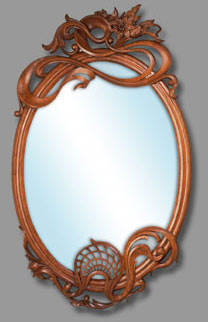
Finally, I asked Leonid if there was anything he wanted to tell you, my readers, and he said he wants to wish you “good mood.” I was baffled until my translator, who was also born in Moscow, came through with a cultural explanation.
“In Russia ,” Diana explained, “it is common to wish things, like luck or happiness. For example, I might wish your heart would hurt from how much love you have, your hands would hurt from how many friends you have to shake hands with, and that when you die, your casket be made from a tree that won’t be planted for another hundred years. ‘Good mood’ is a very upbeat and joyous wish, and one that is quite common in Russia where it means much more. It means you will be happy, so don’t worry.”
Maybe so, but as for me, I just wish I could carve like Leonid.





